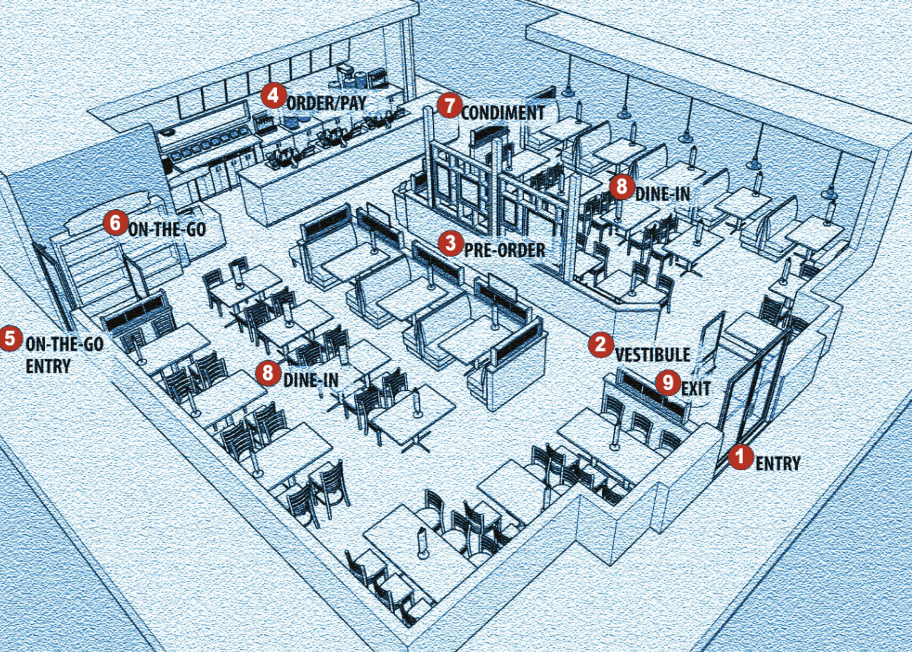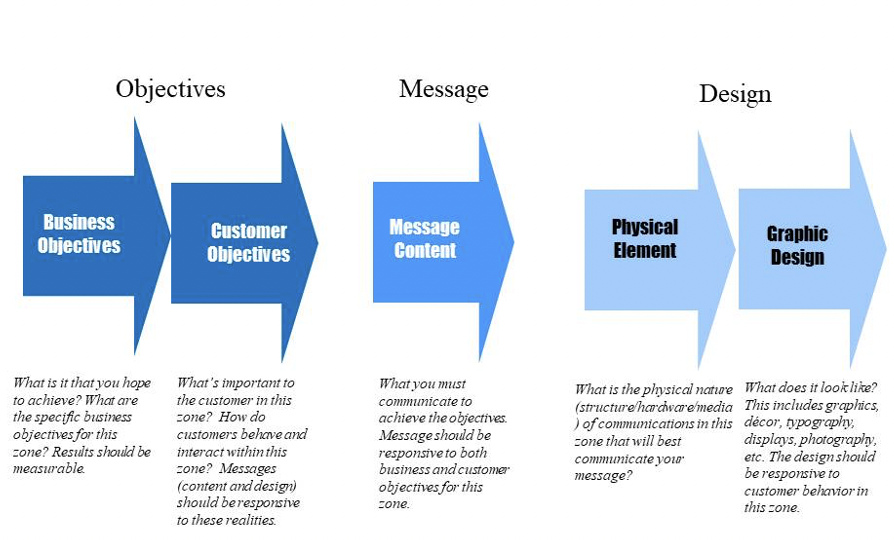Arguably, the menuboard is one of the most critical communicators when it comes to merchandising the food and beverages that a QSR or fast casual restaurant offers. But the menuboard is not the be-all and end-all when it comes to menu merchandising. The menuboard communications should be supported and fortified by a bevy of menu merchandising located throughout the store.
Collectively, all the menu merchandising (both on and off the menuboard) should be driven by the business objectives and tactics identified in a brand’s Menu Strategy document. Creating and agreeing on a Menu Strategy is an essential first step in how world-class menu merchandising is developed. The menu strategy establishes and prioritizes how each menu category and each menu item within a category will help grow the business. Business objectives are developed (and prioritized). Tactics are developed (and prioritized) for how to achieve the business objectives. The menu strategy becomes the roadmap for optimizing menu merchandising along the customers’ entire path to purchase (P2P).
Many menu merchandising initiatives aren’t very strategic
That's because many restaurants tend to think "holistically" about their environments. One space, one communication strategy. They develop broad solutions that are intended to be used anywhere in their stores. Here, there and everywhere. Banners, posters, danglers, wobblers — you name it. Up they go throughout the store, hoping for the best. But that's a surefire way to sub-optimize your menu merchandising.
Start thinking about “customer zones”
The most successful restaurants have recognized that their stores are not just one big space. Each store is a collection of many individual “customer zones.” Customers behave differently in each zone. Their needs, expectations and behaviors are different from one zone to the next. Each of these unique zones is right for one merchandising strategy and dead wrong for another. By identifying these zones and understanding how customers behave in each zone, and by anticipating what needs customers have in a particular zone, you can develop zone-specific merchandising strategies that are keenly responsive to how customers use these zones, and the information they seek in a particular zone. Getting this right makes the customer experience faster, easier, and more enjoyable while maximizing business results.
The concept of developing menu merchandising based on "customer zones" was pioneered by King-Casey decades ago. This blend of science and creativity is used to develop a total store menu merchandising strategy. The acronym "COZI®" (Customer Operating Zone Improvement) captures the methodology now used by many leading QSR and fast casual concepts. COZI® involves a multi-step process, as follows:
1. Zone Assessment. Understand your environment and your customers. Begin by identifying all of the customer zones within your store. What are your "zones of opportunity"? Using a QSR or fast casual restaurant as an example, these zones typically include the following (See Figure 1).

Any restaurant series of many different customer zones. By identifying these and understanding how customers interact in these zones, you can develop menu merchandising strategies that optimize business results while improving the customer experience. In this flog*plan of a fast casual restaurant, we have identified nine distinct customer operating zoie.
Think about how customers use and interact with these zones. Measure the time they spend in each zone. For each zone, probe to discover customer needs, attitudes, and behaviors. Qualitative consumer research can be helpful here.
Now walk around your store and do an assessment of your current menu merchandising. Are your message strategies appropriate for the zones they call home? Do you have the right message for the right zone? How can messages in each zone be better optimized to drive sales?
2. Zone Strategy. This step consists of three elements: What is it that you want to achieve; what is it that you want to say; and how you are going to say it? (See Figure 2)

The COZI® approach to menu merchandising. Once you’ve identified all the zones in your store, it’s time to develop a merchandising strategy for each zone. Developing a strategy involves a multi-step process. This ensures that the resulting merchandising and communication pieces work effectively within specific zones. Note that the actual “design” is the last step. When you get the strategic elements right, you can increase sales, profits, throughput, and customer satisfaction. And that can result in an enviable edge over the competition.
Business Objective. We begin by identifying the business objectives for each of the zones. This is where your menu strategy comes into place. What is it that you hope to achieve in this zone? Note that your business objectives may vary from zone to zone.
Customer Objectives. What are the needs that are important to customers in this zone? At the entry zone, customers want to know if there are any new, seasonal or promotional items being offered.
Message Content. What is it that you must communicate to achieve your business objectives for this zone? The message should be responsive to how customers use this zone (i.e., you don’t want a long and detailed message in the entry zone, as research tells us that customers only take 2–3 seconds to view this message).
Physical Element. What is the physical nature of communications in this zone that will best communicate your message? What would work best in this zone? A stanchion? A window decal? A digital screen?
Graphic Design. Note that the last step in the zone strategy process is "design" (the creation of graphics, images, typography, branding, etc.). This is what the merchandising will look like. It's tempting to jump straight to design. But don’t. Design should be driven by thoughtful analysis and strategy development. Attractive images do not necessarily result in attractive business improvement.
Sounds simple? It’s just common sense, you say? You’re right! But it’s amazing how many organizations overlook the value of developing menu merchandising strategies based on “customer operating zone improvement.”
COZI® absolutes
From our experience with hundreds of COZI® initiatives, we can identify the key things that you should absolutely do:
- Avoid "holistic" merchandising strategies by recognizing that a store is a collection of many different customer zones — with each zone having zone-specific messages.
- Understand exactly how customers make use of each zone. Customer research helps objectively evaluate customer behavior and identify opportunities for improvement.
- For each customer zone, develop merchandising and communications strategies, guided by the brand’s menu strategy.
- Develop strategies that are designed to achieve specific business objectives and are responsive to customers' behavior in these zones.
- Develop measures of success and monitor results. Measures will help determine ROI.
- Based on results, enhance your strategies to continually improve outcomes and customer satisfaction.

